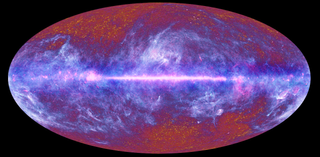
Data from the Planck satellite reveals the cosmic microwave background.
(Image: © ESA and the Planck Collaboration)
The
shape of the universe is one of the most important questions in cosmology, with far-reaching implications, up to and including the ultimate fate of the cosmos.
For decades, we've been measuring our universe to be geometrically flat, but a team of cosmologists are now reporting that our latest measurements actually prefer something rounder. But there's far more to the story than a simple measurement.
Know the curves
The surface of the Earth is curved. We know this because the tiles of geometry that you learned in high school don't always apply. For example, parallel lines don't always stay parallel on the Earth: lines of longitude intersect at the north and south poles, something that can never happen on a flat plain. And if you were to draw a triangle connecting three cities on the Earth, you would find that the angles inside that triangle add up to more than 180 degrees; again, good luck doing that on a flat plain.
Astronomers are very curious about the ultimate curvature of the universe: how do parallel lines and triangles behave on the very largest scales? They care because the shape of the universe is intimately connected to its fate. Einstein's
theory of general relativity, which we use to understand the cosmos, tells us that the contents of space-time affect its shape, and the shape tells the contents how to move.
A geometrically flat universe will just keep on expanding forever, while a "closed" one will eventually pull back in on itself, leading to the reverse of the
Big Bang, something called the Big Crunch.
Look to the light
To test the geometry of space-time, we need to look at all sorts of distant sources and determine if the light from those sources has undergone any major deviations in its path to us. Light beams should stay on the straight and narrow over billions of years, so we can use distant probes to "smooth over" tiny little bumps and wiggles like those caused by galaxies and
black holes, and look at the true, underlying geometry of the universe.
Enter the
cosmic microwave background (CMB), a bath of light soaking the universe, left over from when our cosmos was just a baby, only 380,000 years old. That light has spent the past 13.8 billion years racing to us, so we can study features in the CMB to test our universe for flatness.
The
Planck satellite, a joint effort between NASA and the ESA, was the latest effort to map the CMB across the whole sky. Planck did a really good job, measuring the CMB to the greatest level of precision yet, with its most recent data released in 2018.
And if you look at the bare, raw, naked data of the CMB as recorded by Planck, it seems that our universe might just prefer to be closed. The measurement isn't significant enough to be considered ironclad, but it's still suggestive. This is intriguing because everything we know through our theory of the Big Bang suggests that instead our universe should be very, very flat.
What's going on?
Taking the Planck data hinting at a curved universe in isolation, we have two possible options:
— Planck is telling the truth, and the universe just might be curved.
— Planck is lying to us, and either something in the instrument itself or some other astronomical source (for example, pesky interstellar dust) is making the universe look curved, but it really is flat.
The Planck Collaboration itself did a lot of analysis and checking, and came to the conclusion that our universe is really flat, but that some other contaminant is nudging the data to make it look curved.
But more recently, a trio of astronomers performed their own analysis and came to the opposite conclusion: Planck is not a liar, and
the universe is indeed curved.
What's the answer?
Eyewitness accounts
Ask any detective, and they'll tell you that eyewitness testimony is always shaky. You need multiple, unconnected people giving similar accounts of an incident before you can paint a reliable portrait. And so to determine if Planck is lying to us or not, we need to ask some other eyewitnesses.
Thankfully, cosmologists have a lot to draw from, with measures aplenty that inform us about the curvature of the universe.
The Planck team took a straightforward approach. The researchers combined the data from the Planck satellite with data from other observations, mixed them all together (in a statistically appropriate way) and asked the combined data set about the curvature of the universe. The answer? No curvature at all; we live in a flat cosmos.
According to Planck team members, their own data aren't perfect trustworthy when it comes to curvature, and the measurements of the CMB have to be combined with other cosmological probes to get an accurate answer.
But the trio of astronomers took a different approach. They believe that Planck is telling the truth, by itself, about the curved universe. So when they go to mix in the other probes, they find a tension, because the other eyewitnesses tell us that we live in a flat universe — hence the controversy over a possible "crisis" in cosmology. (Note that this crisis is different than the one regarding
potential differences in the expansion rate of the universe.)
So is Planck lying to us or not? The Planck Collaboration says yes; the trio of astronomers (who also happen to be members of the Planck Collaboration) say no. While a curved universe seems very unlikely, only more data and more digging in will settle the dispute.





Comments
Post a Comment